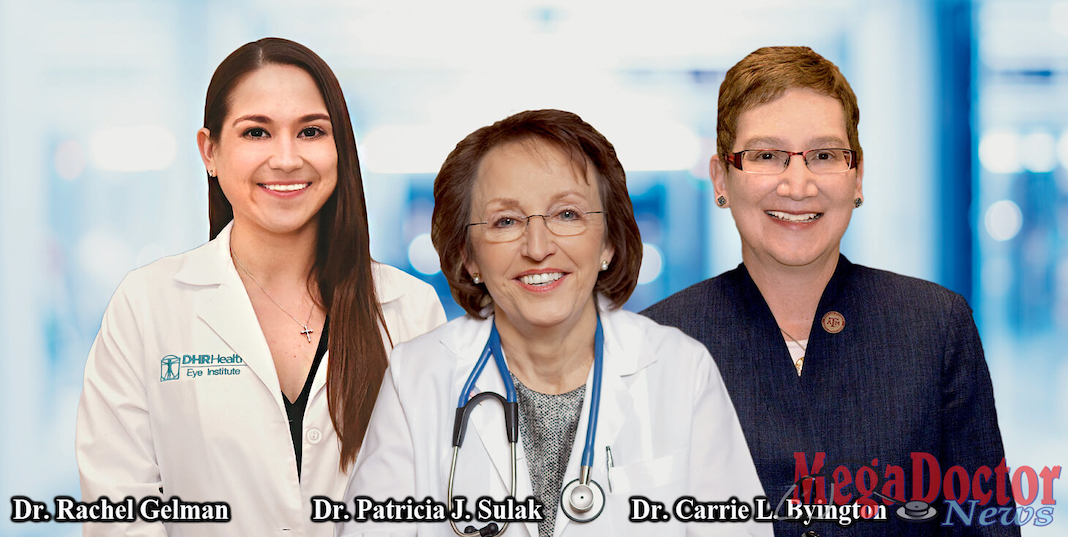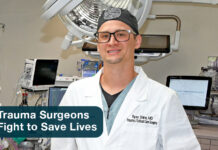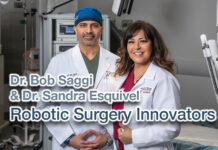By Roberto Hugo Gonzalez
As originally published by Mega Doctor News newsprint July 2019 edition.
Dr. Carrie L. Byington: “We’d Bring A Fight to Every Fighting Chance.”

I have had the privilege of meeting each one of these physicians and getting to know them. They all had the same intentions of serving their communities with their specialties. They are relentless, dedicated medical doctors who are good at what they do.
Dr. Byington visited McAllen as Dean of the Texas A&M College of Medicine and is the Senior Vice President of the Texas A&M University Health Science Center. She is also the Vice Chancellor for Health Services at The Texas A&M University System.
Dr. Byington came to speak about essential health matters and the work being done throughout the state of Texas. Here is a little peek of who she is and does at Texas A&M.
First of all, according to Dr. Byington, their focus is on three priority areas, which include; improving rural population, providing care to active duty military and veterans, and collaborating with engineering to develop and implement new innovations to support health care in the 21st century. The impact of Texas A&M and her work is well known and respected.
“It is just my privilege and honor to be here today, I feel like I’m coming home,” she told an audience attending the event at the McAllen Chamber of Commerce.
Dr. Byington told an audience that included Texas State Representatives, Armando “Mando” Martinez, and Robert “Bobby” Guerra. Also attending were former McAllen mayor and commissioner Richard Cortez (now county Judge), Keith Patridge, President and CEO of McAllen EDC, and Mike Perez, Weslaco City Manager.
“I grew up in Texas, and I trained at Baylor College of Medicine in Houston,” she said. Dr. Byington became a pediatrician at Texas Children’s Hospital and an infectious disease physician at the University of California San Francisco. Her first faculty appointment was at the University of Utah where she remained for 21 years.
She said, “We expand from Dallas all the way to McAllen. We cover a large portion of the geography of Texas, and we have a great deal of expertise.”
Dr. Byington took this opportunity to play a video that showed the Texas A&M team taking part in the work being done in Texas. “They are faculty, staff, and students; we’re exceptionally proud of them.”
The message was inspirational and a provocative call to action. the text asked these important questions; “What if creating a healthier world wasn’t just a nice thought, and we put it at the top of our to-do list. What if we brought world-class care to downtown and small towns? What if we delivered the next generation of innovators, advocates, caregivers, and lifesavers?
The video continued and ended with these powerful words: What if stands firmly against why and goes hand in hand with why not? So why not us? We don’t look back; our drive is unstoppable. We ask what if and then we make it possible.
You can read the rest of Dr. Byington’s story here.
Dr. Patricia J. Sulak: “Self-induced Disease is Killing America”

Dr. Sulak is a nationally recognized practicing physician, researcher, speaker, and medical school professor. She was a guest speaker and member of the faculty at the 26th Annual Rio Grande Valley Medical, Education Conference & Exposition.
This year’s theme titled “Reaching New Horizons” was specially designed for primary care physicians and medical practitioners in the following specialties: family medicine, internal medicine, pediatrics, OB-GYN, surgery, emergency medicine, and infectious diseases.
Dr. Sulak is a gynecologist; she sees patients two days a week. Her speaking engagements keep her traveling all over the United States, sharing her knowledge on important essentials related to wellness.
“We are killing ourselves, and first among the top killers is physical inactivity, which is becoming the number one killer.” She said, “We’re not moving, we’re sitting too much all day long. Excessive and unhealthy food consumption is another; we are eating more than our body can get rid of. Excessive alcohol consumption, unfortunately, has become socially acceptable and it’s not good.”
“Unfortunately, we have a narcotic pain medication epidemic. We have millions of people that are addicted to these powerful, narcotic pain medications. All of this unhappiness is actually causing an increase in suicide rates in America even though we’re using antidepressants more than ever before.” She said, “My job is to do everything I can to prevent disease, and anything that I can’t prevent, then my doctor is going to help me.”
Dr. Sulak is the author of a book called, Should I Fire My Doctor?In this book and during her keynote addresses and conferences, she delineates the eleven essential elements of health and happiness. She is keen on empowering everyone to take ownership of their well-being and partner with their healthcare providers for optimal health. So, don’t fire your doctor.
She emphasized, “We all have to realize and to take ownership of our health, and let the doctor do the part they can do.” She continued, “But you can do so much more than your doctors can do for your health. There is no doubt about it. And this is coming from a doctor.”
In her book, she talks about the 11 essential elements that help work on five aspects of health, they form the framework of Living WELL AwareTM. “These 11 elements encompass the five aspects of our health as discussed by the World Health Organization.” She said, “We need to be concerned about our physical health, our emotional health, our social health, the quality of our relationships, our financial health – what are we doing with our money, and more importantly our spiritual health.”
The second topic of her lecture was Why People Die? Her explanation is straightforward, “We refuse to give up things that are bad for us.” She said, “It’s different for everybody. For some people they refuse to give up their excessive, eating unhealthy foods or alcohol. For others it’s gambling, and for some people, it’s pornography, or just sitting on the couch watching TV programs that are not helping at all.”
Dr. Sulak said that sometimes we’re more worried about other people’s problems than we are our own. “We can’t change other people, but for sure we can change ourselves.”
Click here to read the complete story.
Dr. Rachel Gelman, Ophthalmologist Performing Revolutionary Eye Surgery

Mega Doctor News introduced Dr. Rachel Gelman to our readers. She is an ophthalmologist at the DHR Health Eye Institute.
Dr. Gelman told Mega Doctor News that though she manages a variety of ophthalmic pathologies, she specializes in the treatment of disorders of the cornea and anterior segment of the eye. Her expertise is corneal transplantation and complex cataract and intraocular lens surgeries, in which she applies the latest techniques to her patients.
Dr. Gelman is a physician whose education and training in her field make her a unique professional. She brings solutions to diseases that are highly prevalent in the Rio Grande Valley.
Just to give you an idea of her academic preparation, she was part of the University of Texas-Pan American (now UTRGV) and Baylor College of Medicine combined Bachelors-M.D. program, receiving full scholarships from both institutions, and accepted to medical school while she was still in high school.
Upon graduation from Baylor College of Medicine, she completed an internship at Wayne State University in Detroit, followed by a residency in ophthalmology at the University of Arizona in Tucson. After her general training in ophthalmology, she completed specialty training.Dr. Gelman pointed out, “I did my fellowship in cornea, anterior segment and refractive surgery at the Gavin Herbert Eye Institute at the University of California in Irvine.” Upon completion, she finally moved back to the Valley.
Cornea transplantation is a unique procedure and she is the only physician performing it in the Rio Grande Valley. The fact that Dr. Gelman decided to come back to this region is an exceptional advantage to local residents needing her services. She said, “That’s one of the reasons that I came back to the Valley. It’s a wonderful opportunity for me to be able to offer something needed by my community. And it’s always been my dream to come home and give back in some way to the people of the Valley.”
Dr. Gelman said enthusiastically that she is fascinated by her profession and the field of corneal transplantation. Because there was a great need for this in the Valley, she believed it was her calling to come back.
Dr. Gelman discussed some aspects of her practice, “The cornea is the clear dome at the front of the eye, that I like to call the windshield of the eye. It has various layers and has to be transparent and thin for it to do its job well, which is to allow you to see clearly.”
She had recently performed a procedure called DMEK, which stands for Descemet Membrane Endothelial Keratoplasty. She explained that DMEK is a type of partial-thickness corneal transplant. This new technique removes solely the layer of the cornea that’s damaged and replaces it with a layer of healthy cells. She said, “This is revolutionary. By replacing the damaged part exclusively, leaving the remainder of the original cornea intact, healing is accelerated, and outcomes are improved. This procedure requires great skill because the layer needing replacement is not only extremely fragile, but only 10 microns thick, and nearly invisible to the naked eye. It’s a very delicate and beautiful operation.”
For more info on Dr. Gelman, click here or follow this link to her website: gelmanvision.com




















